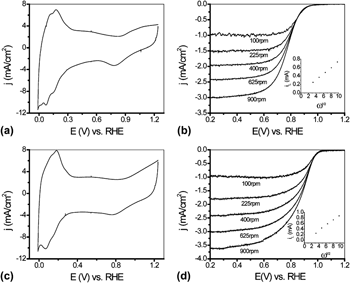Crossref Citations
This article has been cited by the following publications. This list is generated based on data provided by
Crossref.
Elbaz, Lior
Kreller, Cortney R.
Henson, Neil J.
and
Brosha, Eric L.
2014.
Electrocatalysis of oxygen reduction with platinum supported on molybdenum carbide–carbon composite.
Journal of Electroanalytical Chemistry,
Vol. 720-721,
Issue. ,
p.
34.
Shao, Yuyan
Cheng, Yingwen
Duan, Wentao
Wang, Wei
Lin, Yuehe
Wang, Yong
and
Liu, Jun
2015.
Nanostructured Electrocatalysts for PEM Fuel Cells and Redox Flow Batteries: A Selected Review.
ACS Catalysis,
Vol. 5,
Issue. 12,
p.
7288.
Lori, Oran
and
Elbaz , Lior
2015.
Advances in Ceramic Supports for Polymer Electrolyte Fuel Cells.
Catalysts,
Vol. 5,
Issue. 3,
p.
1445.
Huerta, Maria
and
García, Gonzalo
2015.
Micro & Nano-Engineering of Fuel Cells.
p.
95.
Elbaz, Lior
Phillips, Jonathan
Artyushkova, Kateryna
More, Karren
and
Brosha, Eric L.
2015.
Evidence of High Electrocatalytic Activity of Molybdenum Carbide Supported Platinum Nanorafts.
Journal of The Electrochemical Society,
Vol. 162,
Issue. 9,
p.
H681.
Sharabi, Ronit
Wijsboom, Yair Haim
Borchtchoukova, Nino
Finkelshtain, Gennadi
and
Elbaz, Lior
2016.
Methodology for the design of accelerated stress tests for non-precious metal catalysts in fuel cell cathodes.
Journal of Power Sources,
Vol. 335,
Issue. ,
p.
56.
Nabil, Y.
Cavaliere, S.
Harkness, I.A.
Sharman, J.D.B.
Jones, D.J.
and
Rozière, J.
2017.
Novel niobium carbide/carbon porous nanotube electrocatalyst supports for proton exchange membrane fuel cell cathodes.
Journal of Power Sources,
Vol. 363,
Issue. ,
p.
20.
Alonso-Vante, Nicolas
2018.
Chalcogenide Materials for Energy Conversion.
p.
169.
Gonen, S.
Lori, O.
Cohen-Taguri, G.
and
Elbaz, L.
2018.
Metal organic frameworks as a catalyst for oxygen reduction: an unexpected outcome of a highly active Mn-MOF-based catalyst incorporated in activated carbon.
Nanoscale,
Vol. 10,
Issue. 20,
p.
9634.
Gonen, Shmuel
Lori, Oran
Fleker, Ohad
and
Elbaz, Lior
2019.
Electrocatalytically Active Silver Organic Framework: Ag(I)‐Complex Incorporated in Activated Carbon.
ChemCatChem,
Vol. 11,
Issue. 24,
p.
6124.
Chourashiya, Muralidhar
Gyergyek, Saso
and
Andersen, Shuang Ma
2020.
Solution combustion synthesized ceria or alumina supported Pt as cathode electrocatalyst for PEM fuel cells.
Materials Chemistry and Physics,
Vol. 242,
Issue. ,
p.
122444.
Gonen, Shmuel
Lori, Oran
Zion, Noam
and
Elbaz, Lior
2023.
Conductive Ytterbium Metal–Organic Framework Composite: A Lanthanide-Based Complex ORR Catalyst.
The Journal of Physical Chemistry C,
Vol. 127,
Issue. 8,
p.
3960.
Lori, Oran
Kozhushner, Alisa
Honig, Hilah C.
and
Elbaz, Lior
2023.
Enhanced oxygen reduction and fuel cell performance and durability of ultra-low loading Pt-supported high surface area titanium nitro-carbide.
Journal of Power Sources,
Vol. 559,
Issue. ,
p.
232620.
Kozhushner, Alisa
Li, Qing
and
Elbaz, Lior
2023.
Heteroatom-Doped Carbon Supports with Enhanced Corrosion Resistance in Polymer Electrolyte Membrane Fuel Cells.
Energies,
Vol. 16,
Issue. 9,
p.
3659.
Peles‐Strahl, Leigh
Persky, Yeela
and
Elbaz, Lior
2023.
Design of advanced aerogel structures for oxygen reduction reaction electrocatalysis.
SusMat,
Vol. 3,
Issue. 1,
p.
44.
Lin, Zijie
Sathishkumar, Nadaraj
Xia, Yu
Li, Shenzhou
Liu, Xuan
Mao, Jialun
Shi, Hao
Lu, Gang
Wang, Tanyuan
Wang, Hsing‐Lin
Huang, Yunhui
Elbaz, Lior
and
Li, Qing
2024.
Tailoring Zirconia Supported Intermetallic Platinum Alloy via Reactive Metal‐Support Interactions for High‐Performing Fuel Cells.
Angewandte Chemie,
Vol. 136,
Issue. 26,
Lin, Zijie
Sathishkumar, Nadaraj
Xia, Yu
Li, Shenzhou
Liu, Xuan
Mao, Jialun
Shi, Hao
Lu, Gang
Wang, Tanyuan
Wang, Hsing‐Lin
Huang, Yunhui
Elbaz, Lior
and
Li, Qing
2024.
Tailoring Zirconia Supported Intermetallic Platinum Alloy via Reactive Metal‐Support Interactions for High‐Performing Fuel Cells.
Angewandte Chemie International Edition,
Vol. 63,
Issue. 26,
Wang, Fengyi
Huang, Zhixiong
Xu, Bo
Yang, Xueyuan
and
Huang, Wenchao
2025.
Biomimetic functional Aerogels: From design Strategy, preparation to application advances.
Chemical Engineering Journal,
Vol. 507,
Issue. ,
p.
160511.
